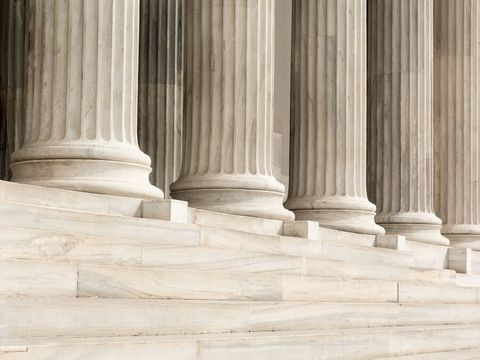Will Jarkesy Stop the IRS from Asserting Penalties Against Taxpayers?
What You Need to Know
Key takeaway #1
Jarkesy may remove the IRS’s ability to levy penalties if a court determines that monetary penalties are legal in nature.
Key takeaway #2
Fines are legal in nature if (1) they are punitive and (2) the penalty is designed to remedy conduct that resembles common law causes of action.
Key takeaway #3
If a court determines that a penalty is punitive and is designed to remedy conduct like a common lawsuit (e.g., negligence), then the court may conclude that civil penalties, without a jury, are unconstitutional.
Client Alert | 6 min read | 10.24.25
Background: Securities and Exchange Commission v. Jarkesy, 603 U.S. 109 (2024).
In 2024, the U.S. Supreme Court determined that the civil penalties issued by the SEC against individuals for committing securities fraud were unconstitutional because they were levied without a jury trial.[1]
The Supreme Court in Jarkesy explained that the constitutionality of civil penalty proceedings turns on the nature of the underlying suit. The key question is whether the suit is considered one that is ‘legal in nature’ as opposed to ‘equitable in nature.’[2] This distinction refers to a historical English practice, in which legal and equitable courts were distinct, the former dealing with controversies demanding monetary remedies for established rights and the latter adjudicating disputes where monetary penalties were inappropriate or insufficient to make up for the harm caused. Suits that were ‘legal in nature’ were heard by courts of law.
While the Court did not extend its holding to civil penalties levied by other administrative federal agencies—like civil penalties issued by the IRS—the Jarkesy decision serves as a warning to peer executive agencies that administer civil penalties in the absence of a jury. Because civil penalties from the IRS do not provide for a jury trial for taxpayers challenging audit determination in Tax Court—and only provide for a jury trial in U.S. District Court after the taxpayer pays the assessed penalty[3]—it is possible that Jarkesy extends to civil penalties levied by the IRS.
Indeed, Justice Gorsuch, who concurred with the majority, hinted of this possibility. He emphasized that the Seventh Amendment’s right to a jury trial “does not work alone,” but “operates together with Article III [entitling individuals to an independent judge] and the Due Process Clause of the Fifth Amendment [promising trials to be consistent with “time-honored principles”] to limit how the government may go about depriving an individual of life, liberty, or property.”[4] His concern is that individuals who may be deprived of property for allegations of acts like fraud are entitled to a “fair trial in a fair tribunal,” and “a jury must make that decision.”[5]
Jarkesy’s Application to Civil Tax Penalties
Commentators have highlighted Jarkesy’s possible extension to civil tax penalties.
As the Court in Jarkesy held, step one in determining if a suit is legal in nature requires deciding if the remedy provided is punitive. “[L]ike the fraud penalty in Jarkesy, tax penalties serve the functions of deterrence and punishment, imposing monetary sanctions on those who would otherwise play the ‘audit lottery’ without fear of consequence if caught.”[6]Those functions—deterrence and punishment—are ones the Supreme Court highlighted as examples of the punitive ends of law. And “like the SEC penalties at issue in Jarkesy, higher penalty tiers are reserved for conduct deemed more blameworthy.”[7] Much like the degrees of crime, those commentators believe this analysis reflects that generally tax penalties are serving punitive ends.[8]Remedies like these that are punitive in nature historically sound in law—not equity, so step one may track the Supreme Court’s logic in Jarkesy and extend to civil tax penalties.
The Jarkesy Court would then proceed to step two of the “legal-in-nature” inquiry, determining whether the targeted conduct remedied by the penalty resembles a common law cause of action. Here, legal commentators highlight that a “common law cause of action” refers to a request for judicial relief that existed around the time of the founding. As the Supreme Court held, a cause of action that is analogized “to a recognized suit at common law . . . is also protected by the Seventh Amendment,” meaning that a jury has historically heard that type of request for judicial relief.[9]Some believe that tax penalties adjudicated by the IRS could be found analogous to common-law negligence since they “target failure to take reasonable care to discharge the duty to calculate and pay the correct amount of taxes, and unreasonableness is the basic wrong that a negligence suit addresses.”[10] Moreover, those commentators believe that historical evidence suggests that the public rights exception has not encompassed IRS civil penalties.[11] Therefore, applying the Supreme Court’s holding in Jarkesy, step two may also lean in favor of its extension to civil tax penalties.
Other commentators, however, believe Jarkesy does not apply to civil tax penalties.
For them, the first step—whether the remedy is punitive or not—leads them to conclude that civil tax penalties are not as punitive as securities fraud penalties because some of the award in tax fraud cases is remediated to the victim.[12] Moreover, those commentators point out that “IRS penalty decisions are fully reviewable by Article I and Article III courts, satisfying the demands of Due Process”[13] and the Jarkesy litigation was brought by the government instead of by a taxpayer.
For step two—whether the penalty resembles a common law cause of action—the commentators put stock in the fact that the Government could not historically be sued at common law.[14]The Jarkesy Court was concerned about influencing market transactions between private parties, but some commentators believe that “tax penalties do not attempt to influence transactions between private parties” and instead concern “the purely public relationship of Government and taxpayer.”[15]According to them, there may be no analogy to a cause of action from the time of founding and a modern day IRS-taxpayer lawsuit.
One final consideration looks to the historical practice of IRS penalty adjudications without a jury. In Jarkesy, the Court was “suspicious of Congress subverting the role of Article III courts by creating new administrative pathways for asserting penalties” with the Dodd-Frank Act, a piece of legislation that is “only a decade old.”[16] On the other hand, “the administrative and judicial processes for determination and review of the civil tax fraud penalties have stood for over a century.”[17] Thus, this may cut against extending Jarkesy to the tax penalty context.
There are many open questions remaining after Jarkesy. One court has already answered that Jarkesy does not extend to civil penalties levied by the IRS,[18] and another has already answered that it does.[19] But the only question answered on which there is little, if any, debate, is that “[a] taxpayer who elects to bring his suit in the Tax Court has no right, statutory or constitutional, to a trial by jury.” Silver Moss Props., LLC v. Comm'r of Internal Revenue, No. 10646-21, 2025 WL 2416867, at *3 (T.C. Aug. 21, 2025) (internal quotations and citation omitted). While Silver Moss contained expansive language, its holding is relatively narrow, as the case originated in Tax Court by a prepayment petition. Its broader reading—that the IRS may amend its answer in Tax Court to assert a Section 6663(a) penalty—is likely to be challenged on appeal to federal court and may eventually matriculate to the Supreme Court for more clarity.
Conclusion: An Originalist Court Guided by “History and Tradition” May Find IRS Civil Penalties Unconstitutional
Commentators have landed on both sides of this debate. While it is unclear how the Court would rule should they grant certiorari to a case challenging the constitutionality of the IRS’s adjudication of civil tax penalties, the current Roberts Court has tended toward “history and tradition” based rulings.[20] This trend suggests that the Court may weigh historical evidence heavily, especially evidence from the time of the Founding, and engage deeply with the two-step “legal-in-nature” inquiry from Jarkesy. Therefore, if presented with well-documented evidence indicating steps one and two are punitive and existed at common law, the Court could find IRS civil penalties to be unconstitutional.
Crowell would like to thank Annie Kline for her contribution to this alert.
[1] Securities and Exchange Commission v. Jarkesy, 603 U.S. 109, 110 (2024).
[2] See Jarkesy, 603 U.S. at 122.
[3] See HDH Grp., Inc. v. United States, No. 2:24-CV-988, 2025 WL 2711877 (W.D. Pa. Sept. 23, 2025); but see United States v. Sagoo, No. 4:24-CV-01159-O, 2025 WL 2689912 (N.D. Tex. Sept. 19, 2025).
[4] Id. at 141 (Gorsuch, J., concurring).
[5] Id. (internal quotations and citations omitted).
[6] Gray Proctor, Twelve Angry Taxpayers: Why the Constitution Might Guarantee a Jury Trial for Accuracy and Fraud Penalties in Tax Cases After SEC v. Jarkesy, 99 The Florida Bar Journal 58, 61 (May/June 2025) (quoting S. Rep. No. 494 (Vol. 1), 97th Cong. 2d Sess., 272-273 (1982)).
[7] Id.
[8] Steve R. Johnson, Jarkesy, the Seventh Amendment, and Tax Penalties, 79 University of Miami Law Review 461, 492–511 (April 2, 2025).
[9] Proctor, 99 The Florida Bar Journal at 61.
[10] Id. at 62.
[11] Id. at 62.
[12] Steve R. Johnson, Jarkesy, the Seventh Amendment, and Tax Penalties, 79 Univ. of Miami L. Rev., 461, 496 (2025).
[13] Id. at 497, 504.
[14] Id. at 512.
[15] Id. at 496.
[16] Id.
[17] Id.
[18] HDH Grp., Inc. v. United States, No. 2:24-CV-988, 2025 WL 2711877 (W.D. Pa. Sept. 23, 2025).
[19] United States v. Sagoo, No. 4:24-CV-01159-O, 2025 WL 2689912 (N.D. Tex. Sept. 19, 2025).
[20] Emily Bazelon, How History and Tradition Rulings are Changing American Law, The New York Times (Apr. 29, 2024), https://www.nytimes.com/2024/04/29/ magazine/history-tradition-law-conservative-judges.html.
Contacts
Insights
Client Alert | 5 min read | 12.12.25
Eleventh Circuit Hears Argument on False Claims Act Qui Tam Constitutionality
On the morning of December 12, 2025, the Eleventh Circuit heard argument in United States ex rel. Zafirov v. Florida Medical Associates, LLC, et al., No. 24-13581 (11th Cir. 2025). This case concerns the constitutionality of the False Claims Act (FCA) qui tam provisions and a groundbreaking September 2024 opinion in which the United States District Court for the Middle District of Florida held that the FCA’s qui tam provisions were unconstitutional under Article II. See United States ex rel. Zafirov v. Fla. Med. Assocs., LLC, 751 F. Supp. 3d 1293 (M.D. Fla. 2024). That decision, penned by District Judge Kathryn Kimball Mizelle, was the first success story for a legal theory that has been gaining steam ever since Justices Thomas, Barrett, and Kavanaugh indicated they would be willing to consider arguments about the constitutionality of the qui tam provisions in U.S. ex rel. Polansky v. Exec. Health Res., 599 U.S. 419 (2023). In her opinion, Judge Mizelle held (1) qui tam relators are officers of the U.S. who must be appointed under the Appointments Clause; and (2) historical practice treating qui tam and similar relators as less than “officers” for constitutional purposes was not enough to save the qui tam provisions from the fundamental Article II infirmity the court identified. That ruling was appealed and, after full briefing, including by the government and a bevy of amici, the litigants stepped up to the plate this morning for oral argument.
Client Alert | 8 min read | 12.11.25
Director Squires Revamps the Workings of the U.S. Patent Office
Client Alert | 8 min read | 12.10.25
Creativity You Can Use: CJEU Clarifies Copyright for Applied Art
Client Alert | 4 min read | 12.10.25
Federal Court Strikes Down Interior Order Suspending Wind Energy Development






